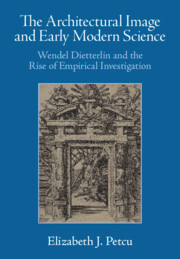
-
Select format
-
- Publisher:
- Cambridge University Press
- Publication date:
- November 2024
- December 2024
- ISBN:
- 9781009422529
- 9781009422536
- Dimensions:
- (254 x 178 mm)
- Weight & Pages:
- 1.16kg, 476 Pages
- Dimensions:
- Weight & Pages:
- Subjects:
- History of Science and Technology, Art, History, Architecture
You may already have access via personal or institutional login- Subjects:
- History of Science and Technology, Art, History, Architecture
Book description
The Architectural Image and Early Modern Science: Wendel Dietterlin and the Rise of Empirical Investigation explores how architectural media came to propel scientific discourse between the eras of Dürer and of Rubens. It is also the first English-language book to feature the polymathic, eccentric, and long-misunderstood artist Wendel Dietterlin (c. 1550–1599). Here, Elizabeth J. Petcu reveals how architectural paintings, drawings, sculptures, and prints became hotbeds of early modern empiricism, the idea that knowledge derives from sensory experience. She demonstrates how Dietterlin's empirical imagery of architecture came into dialogue with the image-making practices of early modern scientists, a rapport that foreshadowed the intimate relationships between architecture and science today. Petcu's astute insights offer historians of art, science, and architecture a new framework for understanding the role of architectural images in the foundations of modern science. She also provides a coherent narrative regarding the interplay between early modern art, architecture, and science as a catalyst for modern empirical philosophy.
Awards
Honorable Mention, 2025 Prize for the Best Book in Literature and Cultural Studies, German Studies Association
Reviews
‘In this immensely learned and beautifully illustrated book, Elizabeth J. Petcu reveals the vast ambitions and stunning virtuosity of Wendel Dietterlin’s architectural images. Petcu illuminates the protean nature of Dietterlin’s work as he strove to realize for architecture the prestige and potential of artistic and natural philosophical inquiry. Working in the creative hothouse of Strasbourg with its unfettered experimentation by artisans and printers, Dietterlin raised architectural image-making to new epistemic status. The book is also a demonstration of Petcu’s own virtuosity and the remarkable versatility of her scholarship – crossing languages, fields, and vast realms of scholarship with ease. Like its protagonist, her book is endlessly inventive.’
Pamela H. Smith - Seth Low Professor of History, Columbia University
‘This important and elegant book transforms our understanding of the relationship between architectural culture and empirical science. Through Petcu’s exacting scholarship, Dietterlin’s corpus has been revealed as a crucible of fertile invention, where design, observation, and fantasy meet. With its remarkable disciplinary and geographical breadth, transporting the reader from Vitruvian architects in Northern Europe to Inca sculptors of colonial Latin America, it should be essential reading for scholars of early modern art and science.’
Alexander Marr - Professor of Renaissance and Early Modern Art, University of Cambridge
Contents
Metrics
Altmetric attention score
Full text views
Full text views help Loading metrics...
Loading metrics...
* Views captured on Cambridge Core between #date#. This data will be updated every 24 hours.
Usage data cannot currently be displayed.
Accessibility standard: Unknown
Why this information is here
This section outlines the accessibility features of this content - including support for screen readers, full keyboard navigation and high-contrast display options. This may not be relevant for you.
Accessibility Information
Accessibility compliance for the PDF of this book is currently unknown and may be updated in the future.

